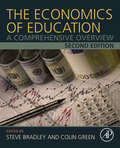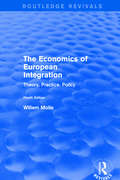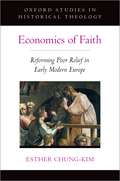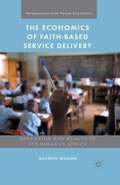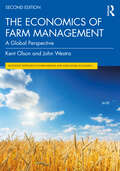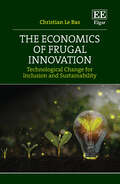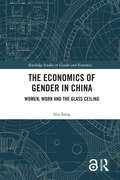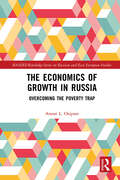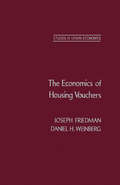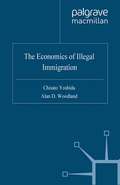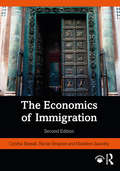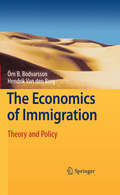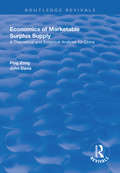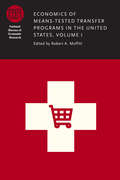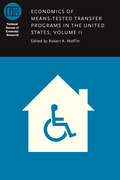- Table View
- List View
The Economics of Education: A Comprehensive Overview
by Steve Bradley Colin GreenThe Economics of Education: A Comprehensive Overview, Second Edition, offers a comprehensive and current overview of the field of that is broadly accessible economists, researchers and students. This new edition revises the original 50 authoritative articles and adds Developed (US and European) and Developing Country perspectives, reflecting the differences in institutional structures that help to shape teacher labor markets and the effect of competition on student outcomes. Provides international perspectives that describe the origins of key subjects, their major issues and proponents, their landmark studies, and opportunities for future researchIncreases developing county perspectives and comparisons of cross-country institutionsRequires no prior knowledge of the economics of education
The Economics of European Integration: Theory, Practice, Policy (Routledge Revivals Ser.)
by Willem MolleThis title was first published in 2001. As economic integration touches ever more areas of society, more and more people are confronted by the bewildering complexity of the functioning of the European Union. Rather than merely focusing on the description of EU policies, this study of the economics of European integration seeks to: select the most relevant aspects and developments; place the wide variety of issues in a robust conceptual structure; integrate theoretical developments with the results of empirical research and of policy analysis; explain the logic of the dynamic processes; describe the structural features of the European economy; highlight the response of private companies to changes in the regulatory environment; depict the historical developments so as to give a sound basis for the understanding of the present situation and the likely future development; and set the European developments in the light of global developments. In practice Western Europe is the focus of major parts of this book.
The Economics of European Integration: Theory, Practice, Policy (Routledge Revivals Ser.)
by Willem MolleThis title was first published in 2001. As economic integration touches ever more areas of society, more and more people are confronted by the bewildering complexity of the functioning of the European Union. Rather than merely focusing on the description of EU policies, this study of the economics of European integration seeks to: select the most relevant aspects and developments; place the wide variety of issues in a robust conceptual structure; integrate theoretical developments with the results of empirical research and of policy analysis; explain the logic of the dynamic processes; describe the structural features of the European economy; highlight the response of private companies to changes in the regulatory environment; depict the historical developments so as to give a sound basis for the understanding of the present situation and the likely future development; and set the European developments in the light of global developments. In practice Western Europe is the focus of major parts of this book.
Economics of Faith: Reforming Poverty in Early Modern Europe (Oxford Studies in Historical Theology)
by Esther Chung-KimEconomics of Faith examines the role of religious leaders in the development of poor relief institutions in early modern Europe. As preachers, policy makers, advocates, and community leaders, these reformers offered a new interpretation of salvation and good works that provided the religious foundation for poor relief reform. Although poverty was once associated with the religious image of piety, reformers no longer saw it as a spiritual virtue. Rather they considered social welfare reform to be an integral part of religious reform and worked to modify existing poor relief institutions or to set up new ones. Population growth, economic crises, and migration in early modern Europe caused poverty and begging to be an ever-increasing concern, and religious leaders encouraged the development and expansion of poor relief institutions. This new cadre of reformers served as catalysts, organizers, stabilizers, and consolidators of strategies to alleviate poverty, the most glaring social problem of early modern society. Although different roles emerged from varying relationships and negotiations with local political authorities and city councils, reform-minded ministers and lay leaders shaped a variety of institutions to address the problem of poverty and to promote social and communal responsibility. As religious options multiplied within Christianity, one's understanding of community determined the boundaries, albeit contested and sometimes fluid, of responsible poor relief. This goal of communal care would be especially relevant for religious refugees who as foreigners and strangers became responsible for caring for their own group.
Economics of Faith: Reforming Poverty in Early Modern Europe (Oxford Studies in Historical Theology)
by Esther Chung-KimEconomics of Faith examines the role of religious leaders in the development of poor relief institutions in early modern Europe. As preachers, policy makers, advocates, and community leaders, these reformers offered a new interpretation of salvation and good works that provided the religious foundation for poor relief reform. Although poverty was once associated with the religious image of piety, reformers no longer saw it as a spiritual virtue. Rather they considered social welfare reform to be an integral part of religious reform and worked to modify existing poor relief institutions or to set up new ones. Population growth, economic crises, and migration in early modern Europe caused poverty and begging to be an ever-increasing concern, and religious leaders encouraged the development and expansion of poor relief institutions. This new cadre of reformers served as catalysts, organizers, stabilizers, and consolidators of strategies to alleviate poverty, the most glaring social problem of early modern society. Although different roles emerged from varying relationships and negotiations with local political authorities and city councils, reform-minded ministers and lay leaders shaped a variety of institutions to address the problem of poverty and to promote social and communal responsibility. As religious options multiplied within Christianity, one's understanding of community determined the boundaries, albeit contested and sometimes fluid, of responsible poor relief. This goal of communal care would be especially relevant for religious refugees who as foreigners and strangers became responsible for caring for their own group.
The Economics of Faith-Based Service Delivery: Education and Health in Sub-Saharan Africa (Perspectives from Social Economics)
by Quentin Wodon KATHRYN LOMASThe Economics of Faith-Based Service Delivery provides the first ever comprehensive empirical assessment of the role that faith-inspired institutions (FIIs) play in the supply of health care and education services in sub-Saharan Africa. Wodon focuses on estimating the market share, reach to the poor, and cost for households that rely on FIIs as opposed to public and private secular providers of education and health care services. He also analyzes the causes of user reliance on FIIs, the comparative performance of FIIs, and the level of satisfaction among those that use their services. The Economics of Faith-Based Service Delivery is an innovate combination of previously untapped nationally representative household surveys, qualitative fieldwork, and insights from the fields of religious studies and social economics.
The Economics of Farm Management: A Global Perspective (Routledge Textbooks in Environmental and Agricultural Economics)
by Kent Olson John WestraFuture farm managers need a range of tools and knowledge to run successful businesses, and this accessible textbook provides the required foundations from economics and management, applied to the farm context. In today’s world where farms are subject to ever-changing industrial, labor, demographic, and technological factors, this textbook provides a clear focus and methodology for business stability and growth. It covers core microeconomic and macroeconomic principles, plus the full range of management topics, from accounting and marketing to operations management and human resource management. It also covers family succession planning and farming mega-trends. This second edition has been updated with the latest data and literature, and gives deeper attention to sustainability and conservation. It also offers a broader range of examples, showcasing the diversity of farm types and farm sizes across the US and globally. Instructor materials are available as digital supplements. This textbook will be a valuable resource for courses in farm management, ranch management, agribusiness, and agricultural economics.
The Economics of Farm Management: A Global Perspective (Routledge Textbooks in Environmental and Agricultural Economics)
by Kent Olson John WestraFuture farm managers need a range of tools and knowledge to run successful businesses, and this accessible textbook provides the required foundations from economics and management, applied to the farm context. In today’s world where farms are subject to ever-changing industrial, labor, demographic, and technological factors, this textbook provides a clear focus and methodology for business stability and growth. It covers core microeconomic and macroeconomic principles, plus the full range of management topics, from accounting and marketing to operations management and human resource management. It also covers family succession planning and farming mega-trends. This second edition has been updated with the latest data and literature, and gives deeper attention to sustainability and conservation. It also offers a broader range of examples, showcasing the diversity of farm types and farm sizes across the US and globally. Instructor materials are available as digital supplements. This textbook will be a valuable resource for courses in farm management, ranch management, agribusiness, and agricultural economics.
The Economics of Frugal Innovation: Technological Change for Inclusion and Sustainability
by Christian Le BasIn light of the tremendous growth of frugal product and process innovations in both emerging markets and economies in the Global North, this book offers a clear understanding of this new direction of technological change within a Schumpeterian analytical framework. Characterising frugal innovation as a new technological paradigm, it illuminates the relationship between frugality and sustainability.Using important case studies from around the globe, Christian Le Bas explores the key characteristics of frugal innovations: products with fewer artefacts, decreasing technological complexity and design simplification. Chapters systematically synthesise economic knowledge on the topic, mapping the environmentally positive consequences of frugal innovation and identifying the crucial socio-economic and ecological contemporary issues that frugal innovation can help resolve.Concise and timely, this book will be a useful resource for economics and management scholars and students. The tools for understanding the nature and scope of frugal innovation, as well as insights on sustainable innovation, also make this an important read for managers, decision-makers and stakeholders.
The Economics of Gender in China: Women, Work and the Glass Ceiling (Routledge Studies in Gender and Economics)
by Sisi SungChina’s rapid socio-economic development has achieved remarkable equalizing conditions between men and women in the aspects of health, education and labor force participation, but the glass ceiling phenomenon has become more prominent. The book develops a cross-disciplinary paradigm, with economics at its core, to better understand gender in China and women in management in the Chinese business context. The theoretical perspective integrates the knowledge and evidence from cognate disciplinary strands, such as economics, sociology, management studies, and the Chinese literature, into one unified framework. In-depth interviews with managers in China’s largest enterprises complement the theoretical perspective with rich empirical details to examine women’s managerial experiences and career choices. The book’s argument sheds light on the power of stereotypes that specify women’s roles in the family, organization, and society. It shows that understanding the socio-psychological and organizational dynamics of stereotyping in the Chinese context, as well as how Chinese women make career decisions, recognizing and deploying these expectations, provides new perspectives on the underrepresentation of women among business leaders in China. The book offers multi-disciplinary evidence on the economics of gender in China that is highly relevant for gender studies in general, and across a number of subject areas, and it can be used in any setting as an introductory reference.
The Economics of Gender in China: Women, Work and the Glass Ceiling (Routledge Studies in Gender and Economics)
by Sisi SungChina’s rapid socio-economic development has achieved remarkable equalizing conditions between men and women in the aspects of health, education and labor force participation, but the glass ceiling phenomenon has become more prominent. The book develops a cross-disciplinary paradigm, with economics at its core, to better understand gender in China and women in management in the Chinese business context. The theoretical perspective integrates the knowledge and evidence from cognate disciplinary strands, such as economics, sociology, management studies, and the Chinese literature, into one unified framework. In-depth interviews with managers in China’s largest enterprises complement the theoretical perspective with rich empirical details to examine women’s managerial experiences and career choices. The book’s argument sheds light on the power of stereotypes that specify women’s roles in the family, organization, and society. It shows that understanding the socio-psychological and organizational dynamics of stereotyping in the Chinese context, as well as how Chinese women make career decisions, recognizing and deploying these expectations, provides new perspectives on the underrepresentation of women among business leaders in China. The book offers multi-disciplinary evidence on the economics of gender in China that is highly relevant for gender studies in general, and across a number of subject areas, and it can be used in any setting as an introductory reference.
The Economics of Growth in Russia: Overcoming the Poverty Trap (BASEES/Routledge Series on Russian and East European Studies)
by Ararat L. OsipianThis book presents theoretical and empirical investigation of economic growth in Russia. The sharp decline in the national production that Russia endured in the 1990s, linked directly to the exhausting and ill-planned transition from the planned economy to the market economy, resulted in Russia plunging into the poverty trap. The goal of this book is to determine whether and how Russia manages to overcome the poverty trap and initiate and sustain economic growth. This book fills the gap between the volatile economic growth as an objective economic reality of Russia and the lack of scholarly literature on the issue. This study identifies the place and role of foreign aid in economic growth in the market-type post-transitional Russian economy and concludes that foreign aid does not play any significant role in the national economy, contrary to what would follow from the classical poverty trap theory, considered, reviewed, applied and tested in this study. Development economists should not overestimate the role of foreign aid in overcoming the poverty trap in those developing economic systems that are currently not in equilibrium and only move toward their steady state. The book will be of interest to those who want to learn more about specific problems in Russia’s newly built capitalism, the country’s perspectives and its current semi-peripheral status. The book will also be an excellent supplement for students in Russian studies programs, as well as for investors who want to do business in Russia and try to understand the country’s domestic economic conditions and processes.
The Economics of Growth in Russia: Overcoming the Poverty Trap (BASEES/Routledge Series on Russian and East European Studies)
by Ararat L. OsipianThis book presents theoretical and empirical investigation of economic growth in Russia. The sharp decline in the national production that Russia endured in the 1990s, linked directly to the exhausting and ill-planned transition from the planned economy to the market economy, resulted in Russia plunging into the poverty trap. The goal of this book is to determine whether and how Russia manages to overcome the poverty trap and initiate and sustain economic growth. This book fills the gap between the volatile economic growth as an objective economic reality of Russia and the lack of scholarly literature on the issue. This study identifies the place and role of foreign aid in economic growth in the market-type post-transitional Russian economy and concludes that foreign aid does not play any significant role in the national economy, contrary to what would follow from the classical poverty trap theory, considered, reviewed, applied and tested in this study. Development economists should not overestimate the role of foreign aid in overcoming the poverty trap in those developing economic systems that are currently not in equilibrium and only move toward their steady state. The book will be of interest to those who want to learn more about specific problems in Russia’s newly built capitalism, the country’s perspectives and its current semi-peripheral status. The book will also be an excellent supplement for students in Russian studies programs, as well as for investors who want to do business in Russia and try to understand the country’s domestic economic conditions and processes.
The Economics of Housing Vouchers
by Joseph H. Friedman Daniel H. WeinbergThe Economics of Housing Vouchers is a seven-chapter text that examines the housing choices of low-income families in two metropolitan areas, namely, Phoenix and Pittsburgh. Some of these households are offered a novel kind of housing subsidy, including a housing allowance or housing voucher, in an experimental framework designed to test this approach to demand-side housing assistance.Chapter 1 presents an overview of U.S. housing programs and the dimensions of the U.S. housing problem. Chapter 2 provides a simple microeconomic model that conceptualizes household behavior, as well as a summary of some of the extant evidence on housing demand. This chapter also estimates the housing demand models for the low-income population in the Demand Experiment, using housing expenditures to measure housing. Chapter 3 applies a hedonic index of housing services that abstracts from particular characteristics of the household or landlord that may affect rent and attempts to measure housing in a more objective manner. Chapter 4 describes a model of household behavior that leads to the methodology for estimating experimental effects. Chapter 5 repeats the analysis for Minimum Rent households, while Chapter 6 examines the effect of both kinds of Housing Gap allowance payment on the consumption of housing services. Lastly, Chapter 7 focuses on the implications of the experimental findings for housing policy. This chapter compares a housing allowance strategy with two other approaches, namely, a pure income-transfer approach and a construction-oriented approach.This book is of value to workers in housing policy, including economists, regional and other social scientists in academia, housing analysts, the Congress, housing lobby groups, and state and local government housing officials.
The Economics of Illegal Immigration
by C. Yoshida A. WoodlandThis book is an extensive review of the current state of illegal immigration in Europe and North America whilst providing theoretical analysis. This analysis models illegal immigration in a two-country framework, highlights the inter-related labour markets and considers a range of immigration policy instruments, including border patrols and employer surveillance and sanctions. Distinguishing between scenarios with and without the international mobility of capital, this book also examines various profit sharing arrangements. Other issues explored include: - The effectiveness of tighter border patrols and internal surveillance upon the level of illegal immigration - The effects upon national and international welfare - And optimal immigration policy choices
The Economics of Immigration
by Cynthia Bansak Nicole Simpson Madeline ZavodnyThis book, in its second edition, introduces readers to the economics of immigration, which is a booming field within economics. The main themes and objectives of the book are for readers to understand the decision to migrate, the impacts of immigration on markets and government budgets and the consequences of immigration policies in a global context. Our goal is for readers to be able to make informed economic arguments about key issues related to immigration around the world. This book applies economic tools to the topic of immigration to answer questions like whether immigration raises or lowers the standard of living of people in a country. The book examines many other consequences of immigration as well, such as the effect on tax revenues and government expenditures, the effect on how and what firms decide to produce and the effect on income inequality, to name just a few. It also examines questions like what determines whether people choose to move and where they decide to go. It even examines how immigration affects the ethnic diversity of restaurants and financial markets. Readers will learn how to apply economic tools to the topic of immigration. Immigration is frequently in the news as more people move around the world to work, to study and to join family members. The economics of immigration has important policy implications. Immigration policy is controversial in many countries. This book explains why this is so and equips the reader to understand and contribute to policy debates on this important topic.
The Economics of Immigration
by Cynthia Bansak Nicole Simpson Madeline ZavodnyThis book, in its second edition, introduces readers to the economics of immigration, which is a booming field within economics. The main themes and objectives of the book are for readers to understand the decision to migrate, the impacts of immigration on markets and government budgets and the consequences of immigration policies in a global context. Our goal is for readers to be able to make informed economic arguments about key issues related to immigration around the world. This book applies economic tools to the topic of immigration to answer questions like whether immigration raises or lowers the standard of living of people in a country. The book examines many other consequences of immigration as well, such as the effect on tax revenues and government expenditures, the effect on how and what firms decide to produce and the effect on income inequality, to name just a few. It also examines questions like what determines whether people choose to move and where they decide to go. It even examines how immigration affects the ethnic diversity of restaurants and financial markets. Readers will learn how to apply economic tools to the topic of immigration. Immigration is frequently in the news as more people move around the world to work, to study and to join family members. The economics of immigration has important policy implications. Immigration policy is controversial in many countries. This book explains why this is so and equips the reader to understand and contribute to policy debates on this important topic.
The Economics of Immigration: Theory and Policy
by Örn B. Bodvarsson Hendrik Van den BergThe inspiration for this book came from a collaborative research project on immigration, begun in 2001, when we were colleagues at University of Nebraska- Lincoln (Bodvarsson was a Visiting Professor there in 2001–05). Our project dealt with the application of Say’s Law to the supply of immigrant labor, meaning that when the supply of immigrant labor grows in an area, the new immigrants, being consumers, bolster labor demand and help to offset the lower wages they may bring about. Our test case was the seemingly obscure Dawson County, Nebraska, where the meatpacking industry experienced a relatively huge increase in Hispanic-born labor supply around 1990. We found for Dawson County this ‘‘demand effect’’ to be signi?cant and our results for this test case generalizable to other, more prominent, test cases. This inspired us to study the famous Mariel Boatlift, where Miami’s labor force grew suddenly by 7% due to the arrival of nearly 125,000 Cuban refugees in the spring of 1980. In that study, we showed that the Marielitos exerted a signi?cant demand effect, which we argue helps to account for the stylized fact that the Mariel in?ux had a relatively benign effect on the Miami labor market. We had the privilege of presenting both studies at various conferences in the USA, Norway, Taiwan and Israel, and these studies have been published in Labour Economics and the Research in Labor Economics series (both studies are discussed in detail in this book).
Economics of Marketable Surplus Supply: Theoretical and Empirical Analysis for China (Routledge Revivals)
by Ping Zong John DavisPublished in 1998. Chinese farm households have been at the centre of the rural reform process since the introduction of the Household Responsibility System in the late 1970’s. There can be little doubt that, for decades to come, they will continue to be a focus of interest both in academic and political circles. This is particularly true in relation to their role of grain sector, when we consider the prominent position of grain in China’s political economy. There is also intense global interest in the impact of the reform process on the country’s future grain self-sufficiency and trade. This book is ambitious in both its scope and remit. Its primary focus is the behaviour of the marketable surplus element of farm households’ grain supply since the beginning of the reform period. The early chapters provide very valuable insights into the nature of the rural reform process; it then looks at the impact of the reforms on the structure of rural economy in general and farm households in particular. This part of the book is rich in statistics on the reform period. In the analytical section the emphasis is on the difficult area of household modelling, covering both theoretical and empirical aspects. Despite the data limitations, which the authors acknowledge, these chapters provide very valuable analyses of the grain price changes. In particular, their use of models which capture the interdependencies between grain marketable surplus supply is a genuine contribution. This book should be read by anyone with an interest in the rural reform process in China and will be of particular relevance to students, scholars and the policy community.
Economics of Marketable Surplus Supply: Theoretical and Empirical Analysis for China (Routledge Revivals)
by Ping Zong John DavisPublished in 1998. Chinese farm households have been at the centre of the rural reform process since the introduction of the Household Responsibility System in the late 1970’s. There can be little doubt that, for decades to come, they will continue to be a focus of interest both in academic and political circles. This is particularly true in relation to their role of grain sector, when we consider the prominent position of grain in China’s political economy. There is also intense global interest in the impact of the reform process on the country’s future grain self-sufficiency and trade. This book is ambitious in both its scope and remit. Its primary focus is the behaviour of the marketable surplus element of farm households’ grain supply since the beginning of the reform period. The early chapters provide very valuable insights into the nature of the rural reform process; it then looks at the impact of the reforms on the structure of rural economy in general and farm households in particular. This part of the book is rich in statistics on the reform period. In the analytical section the emphasis is on the difficult area of household modelling, covering both theoretical and empirical aspects. Despite the data limitations, which the authors acknowledge, these chapters provide very valuable analyses of the grain price changes. In particular, their use of models which capture the interdependencies between grain marketable surplus supply is a genuine contribution. This book should be read by anyone with an interest in the rural reform process in China and will be of particular relevance to students, scholars and the policy community.
Economics of Means-Tested Transfer Programs in the United States, Volume I (National Bureau of Economic Research Conference Report #1)
by Robert MoffittFew government programs in the United States are as controversial as those designed to help the poor. From tax credits to medical assistance, the size and structure of the American safety net is an issue of constant debate. These two volumes update the earlier Means-Tested Transfer Programs in the United States with a discussion of the many changes in means-tested government programs and the results of new research over the past decade. While some programs that experienced falling outlays in the years prior to the previous volume have remained at low levels of expenditure, many others have grown, including Medicaid, the Earned Income Tax Credit, the Supplemental Nutrition Assistance Program, and subsidized housing programs. For each program, the contributors describe its origins and goals, summarize its history and current rules, and discuss recipients’ characteristics and the types of benefits they receive. This is an invaluable reference for researchers and policy makers that features detailed analyses of many of the most important transfer programs in the United States.
Economics of Means-Tested Transfer Programs in the United States, Volume I (National Bureau of Economic Research Conference Report #1)
by Robert A. MoffittFew government programs in the United States are as controversial as those designed to help the poor. From tax credits to medical assistance, the size and structure of the American safety net is an issue of constant debate. These two volumes update the earlier Means-Tested Transfer Programs in the United States with a discussion of the many changes in means-tested government programs and the results of new research over the past decade. While some programs that experienced falling outlays in the years prior to the previous volume have remained at low levels of expenditure, many others have grown, including Medicaid, the Earned Income Tax Credit, the Supplemental Nutrition Assistance Program, and subsidized housing programs. For each program, the contributors describe its origins and goals, summarize its history and current rules, and discuss recipients’ characteristics and the types of benefits they receive. This is an invaluable reference for researchers and policy makers that features detailed analyses of many of the most important transfer programs in the United States.
Economics of Means-Tested Transfer Programs in the United States, Volume I (National Bureau of Economic Research Conference Report #1)
by Robert A. MoffittFew government programs in the United States are as controversial as those designed to help the poor. From tax credits to medical assistance, the size and structure of the American safety net is an issue of constant debate. These two volumes update the earlier Means-Tested Transfer Programs in the United States with a discussion of the many changes in means-tested government programs and the results of new research over the past decade. While some programs that experienced falling outlays in the years prior to the previous volume have remained at low levels of expenditure, many others have grown, including Medicaid, the Earned Income Tax Credit, the Supplemental Nutrition Assistance Program, and subsidized housing programs. For each program, the contributors describe its origins and goals, summarize its history and current rules, and discuss recipients’ characteristics and the types of benefits they receive. This is an invaluable reference for researchers and policy makers that features detailed analyses of many of the most important transfer programs in the United States.
Economics of Means-Tested Transfer Programs in the United States, Volume I (National Bureau of Economic Research Conference Report #1)
Few government programs in the United States are as controversial as those designed to help the poor. From tax credits to medical assistance, the size and structure of the American safety net is an issue of constant debate. These two volumes update the earlier Means-Tested Transfer Programs in the United States with a discussion of the many changes in means-tested government programs and the results of new research over the past decade. While some programs that experienced falling outlays in the years prior to the previous volume have remained at low levels of expenditure, many others have grown, including Medicaid, the Earned Income Tax Credit, the Supplemental Nutrition Assistance Program, and subsidized housing programs. For each program, the contributors describe its origins and goals, summarize its history and current rules, and discuss recipients’ characteristics and the types of benefits they receive. This is an invaluable reference for researchers and policy makers that features detailed analyses of many of the most important transfer programs in the United States.
Economics of Means-Tested Transfer Programs in the United States, Volume II (National Bureau of Economic Research Conference Report #2)
by Robert MoffittFew government programs in the United States are as controversial as those designed to help the poor. From tax credits to medical assistance, the size and structure of the American safety net is an issue of constant debate. These two volumes update the earlier Means-Tested Transfer Programs in the United States with a discussion of the many changes in means-tested government programs and the results of new research over the past decade. While some programs that experienced falling outlays in the years prior to the previous volume have remained at low levels of expenditure, many others have grown, including Medicaid, the Earned Income Tax Credit, the Supplemental Nutrition Assistance Program, and subsidized housing programs. For each program, the contributors describe its origins and goals, summarize its history and current rules, and discuss recipients’ characteristics and the types of benefits they receive. This is an invaluable reference for researchers and policy makers that features detailed analyses of many of the most important transfer programs in the United States.
